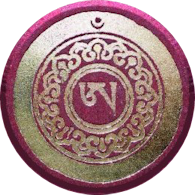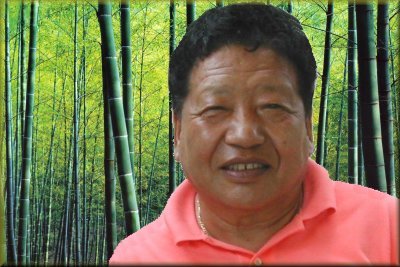
The Special Connection
with the XVIth Gyalwang Karmapa: 9
Akong Rinpoché and the Karmapa Succession
"Now, this particular XVIth Karmapa, who many of us saw during his lifetime, and I myself had the opportunity to serve him until his passing away in Chicago and there are many Kagyu rinpochés but somehow my role was important for the last few years of his life. But I never expected that I would get the job to find the seventeenth [laughter]. There are several hundred Kagyu reincarnations, much wiser than myself, more learned than myself and many of them far better understanding but, in the end, I had to play a big part in the finding." [1]
 Tibetan dharma works first and foremost through the power of the lineages through which its teachings are conveyed. Tibetan Buddhism is in fact defined by the eight great streams of teaching transmission that came from India, known as the Eight Chariots. In the Karma Kamtsang lineage, the role and activity of the Karmapa sits at the heart of its Marpa Kagyu tradition, both in an
external sense—of the Karmapa's activities over the generations in establishing the supports of the Three Jewels and the Three Roots —and the contemplative sense of the Karmapa being the main axis of transmission of its empowerments and teachings.
Tibetan dharma works first and foremost through the power of the lineages through which its teachings are conveyed. Tibetan Buddhism is in fact defined by the eight great streams of teaching transmission that came from India, known as the Eight Chariots. In the Karma Kamtsang lineage, the role and activity of the Karmapa sits at the heart of its Marpa Kagyu tradition, both in an
external sense—of the Karmapa's activities over the generations in establishing the supports of the Three Jewels and the Three Roots —and the contemplative sense of the Karmapa being the main axis of transmission of its empowerments and teachings.
For whatever reasons, probably most of them unfathomable for most of us, Akong Rinpoché—this relatively unimportant leader of a small remote monastery in eastern Tibet and someone who had never figured previously in the great story of the Golden Rosary of Kagyu transmission—was very present and playing a key role in the transition of the Gyalwang Karmapa from the XVIth to the XVIIth incarnation. This significant role, briefly described in the previous pages of this site [2], is mentioned here to contextualise Rinpoché’s enlightened activity in bringing dharma to the world by seeing him as being at least a vital part of the Karmapa’s extended activity and probably more than that, as an emanation of the Karmapa himself.
Whatever influence Akong Rinpoché had in catalysing the process of finding the XVIIth Gyalwang Karmapa is mainly known by the main actors in that story: the Tai Situpa, the Shamarpa, the Goshir Gyaltsabpa, Jamgon Kongtrul Rinpoché and Rinpoché himself. The latter kept most of what was happening very secret and went along/was obliged to go along with the one or two stories of “there is definitely a letter” that the regents felt they had to put out to quell growing public consternation and anger at there being no new developments in the inter-regnum between 1982 and 1990. As Rinpoché himself explains, it was not untrue, because they were all sure there was a letter, but the certainty they declared and some of the details they described were “white lies”—not meant to deceive but to reassure people while they solved the puzzle. Whether the Tai Situpa or the Gyaltsabpa will ever say more about that period is as yet unknown. Jamgon Rinpoché and Akong Rinpoché are no longer alive to add to the details.
In 1981, something of bad augur happened. It was noticed by Akong Rinpoché and mentioned to me privately by him. I must confess I took it lightly at the time and thought he was exaggerating a bit (how mistaken I was!). At the time, Samye Ling had the joint visit of the Tai Situpa and the Shamarpa (Khenchen Thrangu Rinpoché was also there!). Rinpoché asked our photographer, Peter Mannox, to make high-quality photos on his plate camera of both regents together. Akong Rinpoché put a lot of effort into making their thrones exactly the same, in the old shrine room. In all the photos that emerged, the two rinpochés are looking away from each other: not a lot, because they are both looking roughly in the direction of the camera. But the turning-away slightly from each other is noticeable in all the shots (there were a few). Akong Rinpoché was very unhappy about this and said it was not a good sign. This was before the Karmapa’s passing, later in that same year.
Rinpoché was obviously keeping many of his thoughts to himself but already I was trying to piece two and two together and remembered how most of us had been excited by the appearance of the Karmapa Black Hat lama book, by Nik Douglas and Meryl White 1976, with its fascinating information on the lineage and its brilliant photos. Once he had read it, Rinpoché said a little glumly, in reply to my question of his opinion, It’s all right. Decoding that from his language meant there was something quite wrong. I enquired several times and gradually weaned out of him that the authors had, by the look of it, been very influenced by the Shamarpa in the writing and that therefore the book gave the impression that he was more important than the Tai Situpa—the "Red Hat Karmapa" of central importance in the Karmapa “golden rosary” transmission. In fact, the Tai Situpas appear as much in the lineage as do the Shamarpas and they (as well as Gyaltsab Rinpoché and later Jamgon Rinpoché) were also given Red Crowns and Karmapa’s own statement was that each of them was “the same as himself” and that their throne heights should be the same.
It is obvious, in retrospect, that Akong Rinpoché sensed already whatever it was driving the Shamarpa from a very early time. He did not want trouble to happen and he did all he could to avoid it. He received the Shamarpa in Samye Ling with utmost respect and courtesy, giving up his own rooms and house to him and his main attendants and Rinpoché told us all the usual and very respectful things said about the Shamarpa. He also engaged Katia in the publication of a biographical text on the Shamarpas, later published by Samye Ling under the title The Seed of Faith. From the time of those shrine-room photos of both rinpochés onwards, I witnessed Akong Rinpoché’s growing sadness at the damage being done to the Kamtsang lineage by the different stances taken on the issue of the Karmapa succession. As most good lamas did, he encouraged us to see something positive coming out of what seemed very negative and he strongly directed individuals to concentrate on their own minds rather than “Kagyu gossip”. Nevertheless, it was clear how much he treasured the purity of the Kagyu lineage and how much any damage done to it wounded him.
[1] From a talk given in the Samye Ling shrine room in 1992 after Akong Rinpoché's return from Tibet where he had just officially "found" the new Karmapa. A video of this talk will be available through this site soon.
[2] The eight web pages from www.akong.eu/k16_1.htm through www.akong.eu/k16_8.htm or through navigation bar, top of page.
......continue to the next part of the story: Rinpoché's role in the Karmapa succession: Part Two
